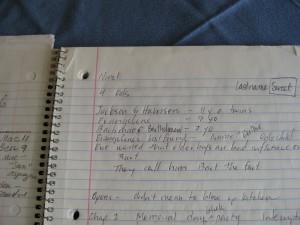5 Ways to Use a Journal to Boost Writing Productivity by Rochelle Melander
 Exercise the writing muscle every day, even if it is only a letter, notes, a title list, a character sketch, a journal entry. Writers are like dancers, like athletes. Without that exercise, the muscles seize up. –Jane Yolen
Exercise the writing muscle every day, even if it is only a letter, notes, a title list, a character sketch, a journal entry. Writers are like dancers, like athletes. Without that exercise, the muscles seize up. –Jane Yolen
Since January, I’ve been exploring art journaling—thanks to an Oprah’s Lifeclass given by Brené Brown. It’s been great fun to journal in a new way—painting, collaging, and drawing. This work has brought new life to every area of my creativity.
As I reflected on my journaling over the years, I realized that journaling can boost writing productivity in multiple ways. I present five of those tools below. But remember: these tools overlap and most can be used in combination with each other.
A note: I like to write on paper. I shop for unique paper and good pens even when I don’t need them. But I also own and use several journaling apps on my iPad—and realize that many of you prefer to use those tools. Do what works for you.
1. Morning pages or Evening pages. Make your first or last action of the day a written one. Jot down one to three sloppy pages of anything that comes to your mind: words, images, memories, events, experiences: whatever. As a consummate morning writer, I’ve been surprised by my recent desire to write at night. So I’ve started bringing my journal to bed with me and before I read, I write.
2. Dreams or Gratitude. For people who like more structure in their morning or evening pages, I suggest using morning pages to write down their dreams or their evening pages to record their blessings from the day. A dream journal can help writers access their subconscious and provide deep images for writing. A gratitude journal can help the writer pay attention to the day.
Pro Tip: A gratitude journal can get pretty rote—at least mine does, and I end the day writing the same three things I’ve written for the last gazillion days! Instead, give yourself a scavenger hunt in the morning—and note it in the evening. Challenge yourself to look for three signs of spring, three examples of young love, three acts of kindness, or even three different kinds of birds. You’ll be surprised at how that small act of intention will help you see more.
3. The Plan. If you’re a regular reader of these pages, you know that I encourage writers to plan! There’s good research to back me up—people who know the when, where, and what of their tasks tend to accomplish them. So if you’ve planned to write a blog post on composting tomorrow from 3-4 PM at your favorite indie coffee shop—and you write that down in your journal—you’re much more likely to do it than say the person who thinks, I’ll do some sort of a blog post sometime tomorrow. Use your journal to plan: the next day, the next year, your new book, whatever.
Pro Tip: The plan doesn’t have to be a technical “how I’m going to do it document.” If you’re a creative, chances are, that won’t work for you. Try mind mapping, making a list, or drawing a map.
4. The Collection. I recently read an article—oh my, I wish I could remember where—about a woman who decided to get organized and used a journal to do it. She wrote down everything in a single journal: phone messages, to-do lists, meeting notes, ideas, and more. I liked the idea. As someone who has journals for just about every single thing I do—the project journal, the blog journal, the daily journal, the dream journal, etc.—this sounded so, well, doable. I’ve started carrying my regular journal with me. I tend to use it for everything: taking notes at author events and business conversations, recording random ideas and bits of dialogue, working through pitches and more.
Pro tip: Tape or paste in information, inspiration, or photos. If you’re using an electronic journal, you can simply take a picture and add it to your file.
5. Journal of a Book. For the past ten years, I’ve kept a journal for every single one of my books. I got the idea from Elizabeth George, who spoke about it when she was in Milwaukee at a book signing many years ago. She got the idea from John Steinbeck and wrote about it in her book on writing, Write Away: “I’ve begun every day by writing in a journal, sometimes about the writing I’m doing, sometimes about what’s on my mind at that moment. So for each novel I now write, I create a new journal entry, but before I do that, I read a day in the last Journal of a Novel for the previous novel. This allows me to see that, whatever I might be experiencing at the moment, I have experienced it and survived it before.” (p. 199)
Pro Tip: Your journal of a novel or nonfiction book can also be your story bible or idea file, where you keep all the bits of information you need to tell the story.
 Bonus Tool: Art Journaling. But I’m a writer! You say. You are. But even writers like to play with color, texture, shape, and more. Any of the journal types above can done as an art journal. For me, art journaling takes one of two forms:
Bonus Tool: Art Journaling. But I’m a writer! You say. You are. But even writers like to play with color, texture, shape, and more. Any of the journal types above can done as an art journal. For me, art journaling takes one of two forms:
+A place to explore an idea or experience through art. These are messy and fun experiments with language.
+A tool for playing with the art medium, without any idea of what I’m trying to communicate.
Don’t worry about how it looks. Explore and have fun.
Your turn: If you’ve used a journal to boost your productivity, leave your suggestions here!
[Tweet “How does #journaling boost your #writing productivity?”]










Thanks for your post Rochelle.
I’ve journaled my devotional times, ever since I started my faith journey, some 36 years ago. And I often end my night by journaling some faith or life thought, that comes to me in the stillness of that closure-of-the-day period.
While I can’t say journaling has helped my productivity (I’m not quite there yet) I can say it has given me
1.) a wealth of ‘primary source’ material to lean on, as needed for example in my upcoming memoir writing project
2.) unlimited time periods of inspiration and focus and gratitude–both at the moment, as well as later, in some of those remarkable read-back times
3.) unlimited writing periods of learning to express my thoughts, my heart, and my mind–and just as important, to develop them!
…among other benefits.
My journals have long been my own place of discovery, and inspiration, and journey-recording. And hopefully, they are leaning themselves into a place of future productivity. (I’m preparing to launch my own blog, shortly. My thoughts are finally ready for public consumption.)
And I’m with you Rochelle–there’s nothing like pen & paper! (I know at least 2 well-known, highly respected writers, who still stick to this old fashioned stuff, like glue. Hooray!)
Now that my own papers have long ago over-run my office, & sometimes our home, hubby is glad to know that I am about to embark on a note-taking tablet purchase (one that instantly converts my messy scrawl, to text!) and I’m looking forward to perhaps somewhat taming the compulsive paper-writing side of me.
I’m getting varicose veins in my writer’s arm. No kidding. None on the other.
~~~ncj
Love this, Nom! What a great testimony to the power of journaling!
Turns out that I use my journal in almost all of these ways!
My journals, like the picture, tend to be in simple 3- or 5-subject college-lined notebooks. I mostly write in the morning, ala Morning Pages. And in those pages, I find myself planning (life, work), writing about writing, collecting ideas, working through issues and all kinds of other things. I find that my life tends to go better when I make it a point to journal on a regular basis.
That’s so cool, Jennifer! And, I’m with you–though I love my Moleskine journals, I also love the plain college-lined notebooks!